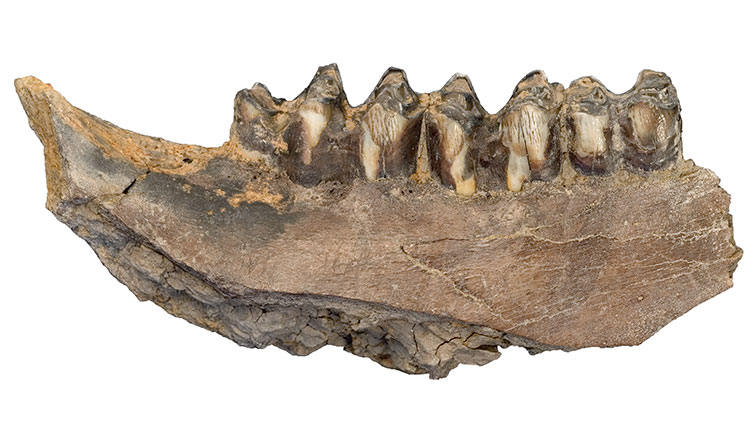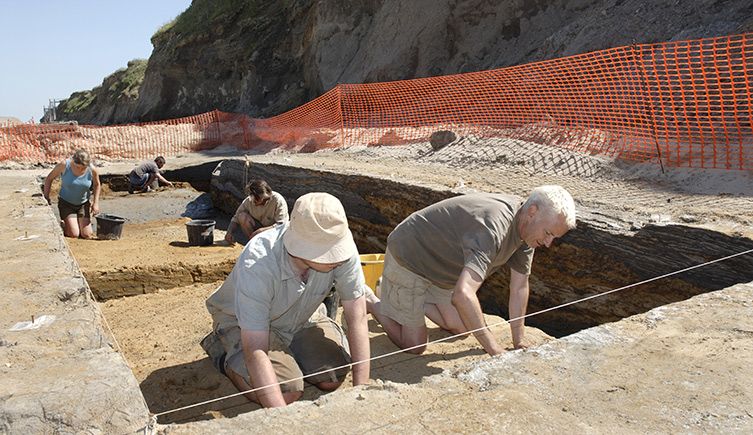Museum staff
- Chris Stringer
- Simon Parfitt
- Mark Lewis
- Rachel Bynoe
Focus: Investigating and dating the early human occupations recorded at Happisburgh in Norfolk
Time period: 1 million-500,000 years ago
Funding:
Calleva Foundation (Pathways to Ancient Britain)
British Museum research fund
The earliest evidence of humans living in northern Europe dates to just under one million years ago. We are studying these sporadic occupations, mainly at sites in East Anglia and focusing on Happisburgh in Norfolk.
These sites are proving to be critical in understanding how early humans adapted to the colder climates of northern latitudes.
With continuing erosion of the coast, our work at Happisburgh has concentrated on monitoring and recording new exposures. Five principal sites have been discovered at Happisburgh - we are currently concentrating on Sites 1, 3 and 5. These include the oldest archaeological site in northern Europe and what may be the world's oldest underwater archaeological site.
Site 1 lies one kilometre south of the village of Happisburgh. At 500,000 years old, it may be the youngest of the five archaeological sites.
Fieldwork suggests the presence of a slow-moving river and marshland at this site. Human occupation is indicated by handaxes, worked flint flakes and butchered bison and deer bones. The rich biological remains reflect a cool interglacial environment with birch and coniferous forest.

Part of a fossilised bison jaw from Happisburgh, Norfolk
At approximately 900,000 years old, Site 3 is the oldest archaeological site in northern Europe. It is notable for its excellent organic preservation of beetle, plant and mammal remains. In 2013 the earliest known human footprints in Europe were discovered just to the south of the site.
Site 3 consists of a complex series of channels cut by a slow-flowing river that was close to its estuary. The river was bordered by grassland and surrounded by conifer-dominated forest.
Human presence at the site is indicated by worked flint flakes and footprints. Winter temperatures may have been at least three degrees Celsius colder than today, but the presence of footprints from what may be family groups and children suggests that the humans at Happisburgh were year-round occupants and able to cope with the long, cold winters.
Footprint size indicates that the tallest individual was about 1.7 metres (5 feet 8 inches) in height. This is consistent with skeletal evidence of the average male Homo antecessor from the broadly contemporaneous site of Atapuerca in northern Spain.
Since 2013 there have been few opportunities for excavation due to high beach sand. Most of the work therefore has involved regular monitoring for new exposures with the help of local volunteers, whose finds are now being systematically recorded.

Excavations at Happisburgh in 2006
This offshore site was first identified through the recovery of blocks of iron-concreted gravel from local beaches. These blocks contain plant remains, butchered bones and stone tool evidence. The mammalian fauna found in the blocks suggests that the site dates to the early Middle Pleistocene. Pollen and plant remains indicate a temperate environment.
The gravel blocks were transported from offshore to local beaches by tidal action. The exact location of Site 5 is still under investigation through diving expeditions.
Various methods for locating Site 5 have been trialled and developed by a dive team from the University of Southampton from 2012 to 2015.
After a few weather-related setbacks, the final dive of the 2015 season saw the identification of in situ, outcropping deposits on an area of seabed known locally as the Monks. The same location also yielded the first fossil find of the dives, a heavily mineralised rhino leg bone. It is possible that this is the broad location of Site 5.
Further dives, in conjunction with geophysical techniques such as side-scan sonar and sub-bottom imaging, will be attempted in the future. If confirmed through diving and sampling, Site 5 would be the world’s oldest underwater archaeological site.

Evidence of stone tool use - a hard-hammer flake - found at Happisburgh
This research is part of Pathways to Ancient Britain (PAB), a suite of projects aimed at investigating the earliest occupations of Britain. PAB is funded by the Calleva Foundation.
Ashton NM, Lewis SG, Parfitt SA, Bates M, Bates R, Bynoe R, Dix J, Hoare PG and Sturt F (2018). Understanding and Monitoring the Cromer Forest-bed Formation. Historic England Research Report: Series no. 62-2018.
Ashton NM, Lewis SG, De Groote I, Duffy S, Bates M, Bates R, Hoare PG, Lewis M, Parfitt SA, Peglar S, Williams C and Stringer CB (2014). Hominin footprints from Early Pleistocene deposits at Happisburgh, UK. PlosOne.
Parfitt SA, Ashton NM, Lewis SG, Abel RL, Coope GR, Field MH, Gale R, Hoare PG, Larkin NR, Lewis MD, Karloukovski V, Maher BA, Peglar SM, Preece RC, Whittaker JE and Stringer CB (2010). Early Pleistocene human occupation at the edge of the boreal zone in northwest Europe. Nature 266: 229-233.